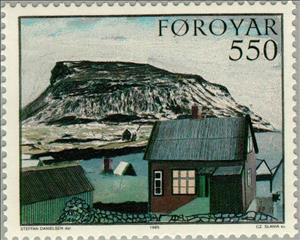Stamp: Paintings (Faroe Islands 1985)
Paintings (Faroe Islands 1985)
01 January (Faroe Islands ) within release Theme goes into circulation Stamp Paintings face value 550 Faroese oyra
| Stamp Paintings in catalogues | |
|---|---|
| Michel: | Mi:FO 120 |
Stamp is square format.
Also in the issue Theme:
- Stamp - Landscapes (painting of Edward Dayes) face value 250;
- Stamp - Landscapes (painting of Edward Dayes) face value 280;
- Stamp - Landscapes (painting of Edward Dayes) face value 550;
- Stamp - Landscapes (painting of Edward Dayes) face value 800;
- Stamp - Paintings face value 450;
- Stamp - Paintings face value 550;
- Stamp - Tórshavn lighthouse,1909 face value 320;
- Stamp - Mykines lighthouse,1909 face value 350;
- Stamp - Map of locations, stylized lighthouse face value 470;
- Stamp - Fokker Friendship face value 300;
- Stamp - Boeing 737 face value 300;
- Stamp - Interisland LM-IKB face value 300;
- Stamp - Helicopter Snipan face value 300;
|
Data entry completed
53%
|
|
|---|---|
| Stamp Paintings in digits | |
| Country: | Faroe Islands |
| Date: | 1985-01-01 |
| Perforation: | 12½ x 12¾ |
| Emission: | Commemorative |
| Format: | Stamp |
| Face Value: | 550 Faroese oyra |
| Print run: | 624000 |
Stamp Paintings it reflects the thematic directions:
A house is a single-unit residential building. It may range in complexity from a rudimentary hut to a complex structure of wood, masonry, concrete or other material, outfitted with plumbing, electrical, and heating, ventilation, and air conditioning systems. Houses use a range of different roofing systems to keep precipitation such as rain from getting into the dwelling space. Houses generally have doors or locks to secure the dwelling space and protect its inhabitants and contents from burglars or other trespassers. Most conventional modern houses in Western cultures will contain one or more bedrooms and bathrooms, a kitchen or cooking area, and a living room. A house may have a separate dining room, or the eating area may be integrated into the kitchen or another room. Some large houses in North America have a recreation room. In traditional agriculture-oriented societies, domestic animals such as chickens or larger livestock (like cattle) may share part of the house with humans.
Painting is the practice of applying paint, pigment, color or other medium to a solid surface (support base). The medium is commonly applied to the base with a brush, but other implements, such as knives, sponges, and airbrushes, can be used. Painting is a mode of creative expression, and the forms are numerous. Drawing, gesture (as in gestural painting), composition, narration (as in narrative art), or abstraction (as in abstract art), among other aesthetic modes, may serve to manifest the expressive and conceptual intention of the practitioner. Paintings can be naturalistic and representational (as in a still life or landscape painting), photographic, abstract, narrative, symbolistic (as in Symbolist art), emotive (as in Expressionism), or political in nature (as in Artivism). A portion of the history of painting in both Eastern and Western art is dominated by spiritual motifs and ideas. Examples of this kind of painting range from artwork depicting mythological figures on pottery, to Biblical scenes rendered on the interior walls and ceiling of the Sistine Chapel, to scenes from the life of Buddha or other images of Eastern religious origin. In art, the term painting describes both the act and the result of the action. The support for paintings includes such surfaces as walls, paper, canvas, wood, glass, lacquer, clay, leaf, copper and concrete, and the painting may incorporate multiple other materials including sand, clay, paper, plaster, gold leaf, as well as objects. The term painting is also used outside of art as a common trade among craftsmen and builders.
A culture is a way of life of a group of people--the behaviors, beliefs, values, and symbols that they accept, generally without thinking about them, and that are passed along by communication and imitation from one generation to the next. Culture is symbolic communication. --the behaviors, beliefs, values, and symbols that they accept, generally without thinking about them, and that are passed along by communication and imitation from one generation to the next. Culture is symbolic communication.



